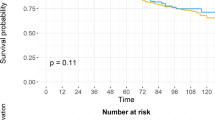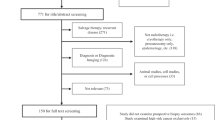Abstract
Background
Androgen deprivation therapy (ADT) has been shown to improve survival for men with intermediate and high-risk prostate cancer undergoing external-beam radiation therapy (EBRT). Using data from a community-based prospective disease registry, we investigated usage of EBRT with or without neoadjuvant ADT.
Methods
The CaPSURE database contains 14,863 men with prostate cancer, including 1337 men diagnosed between 1990 and 2014 with localized disease who received EBRT as primary treatment. Prostate cancer risk was calculated using the CAPRA score. Patient characteristics were compared using the Mantel–Haenszel chi-square test for trend and analysis of variance.
Results
Between 1990 and 2014, 14,010 men were diagnosed with localized disease within the CaPSURE registry. Of those, 1337 underwent EBRT. Patients had a median age of 71 years. The use of ADT in addition to EBRT increased from 24% in 1990 to 60% in 1996 with a decrease seen to 47% in 2011. Men receiving ADT have differing clinical characteristics including higher PSA at diagnosis, higher Gleason grade, and higher CAPRA scores. Median ADT duration was 4 months.
Conclusions
The use of ADT in conjunction with primary EBRT has increased in frequency and duration since 1990. Men receiving ADT have higher risk characteristics than those receiving EBRT alone. There is substantial variability in use of ADT in clinical practice.
This is a preview of subscription content, access via your institution
Access options
Subscribe to this journal
Receive 4 print issues and online access
$259.00 per year
only $64.75 per issue
Buy this article
- Purchase on Springer Link
- Instant access to full article PDF
Prices may be subject to local taxes which are calculated during checkout





Similar content being viewed by others
References
Cooperberg MR, Broering JM, Carroll PR. Time trends and local variation in primary treatment of localized prostate cancer. J Clin Oncol. 2010;28:1117–23.
Zelefsky MJ, Eastham JA, Cronin AM, Fuks Z, Zhang Z, Yamada Y, et al. Metastasis after radical prostatectomy or external beam radiotherapy for patients with clinically localized prostate cancer: a comparison of clinical cohorts adjusted for case mix. J Clin Oncol. 2010;28:1508–13.
Wallis CJD, Saskin R, Choo R, Herschorn S, Kodama RT, Satkunasivam R, et al. Surgery versus radiotherapy for clinically-localized prostate cancer: a systematic review and meta-analysis. Eur Urol. 2016;70:21–30.
Cooperberg MR, Vickers AJ, Broering JM, Carroll PR. Comparative risk-adjusted mortality outcomes after primary surgery, radiotherapy, or androgen-deprivation therapy for localized prostate cancer. Cancer. 2010;116:5226–34.
Barocas DA, Alvarez J, Resnick MJ, Koyama T, Hoffman KE, Tyson MD, et al. Association between radiation therapy, surgery, or observation for localized prostate cancer and patient-reported outcomes after 3 years. JAMA. 2017;317:1126–40.
NCCN Prostate Cancer. National comprehensive cancer network practice guidelines [Internet]. n.d. [cited 2017 Jun 1]. https://www.nccn.org/store/login/login.aspx?ReturnURL=https://www.nccn.org/professionals/physician_gls/pdf/prostate.pdf
Lawton CAF, Lin X, Hanks GE, Lepor H, Grignon DJ, Brereton HD, et al. Duration of androgen deprivation in locally advanced prostate cancer: long-term update of NRG Oncology RTOG 9202. Int J Radiat Oncol Biol Phys. 2017;98:296–303.
Cooperberg MR, Broering JM, Litwin MS, Lubeck DP, Mehta SS, Henning JM, et al. The contemporary management of prostate cancer in the United States: lessons from the cancer of the prostate strategic urologic research endeavor (CapSURE), a national disease registry. J Urol. 2004;171:1393–401.
Cooperberg MR, Broering JM, Carroll PR. Risk assessment for prostate cancer metastasis and mortality at the time of diagnosis. J Natl Cancer Inst. 2009;101:878–87.
D’Amico AV, Chen M-H, Renshaw AA, Loffredo M, Kantoff PW. Androgen suppression and radiation vs radiation alone for prostate cancer: a randomized trial. JAMA. 2008;299:289–95.
Physician Quality Reporting System (PQRS) Measures Group Specifications Manual [Internet] [cited 2016 Jun 11]. https://www.cms.gov/Medicare/Quality-Initiatives-Patient-Assessment-Instruments/PQRS/Urology_Specialty_Meas/Urology_Specialty_Measure_Set.pdf?agree=yes&next=Accept?agree=yes&next=Accept
Park S, Meng MV, Elkin EP, Speight JL, DuChane J, Carroll PR. Androgen deprivation use with external beam radiation for prostate cancer: results from CaPSURE. J Urol. 2005;174:1802–7.
Meng MV, Elkin EP, Latini DM, Duchane J, Carroll PR. Treatment of patients with high risk localized prostate cancer: results from cancer of the prostate strategic urological research endeavor (CaPSURE). J Urol. 2005;173:1557–61.
Cooperberg MR, Grossfeld GD, Lubeck DP, Carroll PR. National practice patterns and time trends in androgen ablation for localized prostate cancer. J Natl Cancer Inst. 2003;95:981–9.
Muralidhar V, Catalano PJ, Reznor G, Mahal BA, Choueiri TK, Sweeney CJ, et al. Variation in national use of long-term ADT by disease aggressiveness among men with unfavorable-risk prostate cancer. J Natl Compr Canc Netw. 2016;14:421–8.
Merrick GS, Butler WM, Wallner KE, Galbreath RW, Allen ZA, Adamovich E, et al. Androgen deprivation therapy does not impact cause-specific or overall survival in high-risk prostate cancer managed with brachytherapy and supplemental external beam. Int J Radiat Oncol Biol Phys. 2007;68:34–40.
Laverdière J, Nabid A, De Bedoya LD, Ebacher A, Fortin A, Wang CS, et al. The efficacy and sequencing of a short course of androgen suppression on freedom from biochemical failure when administered with radiation therapy for T2-T3 prostate cancer. J Urol. 2004;171:1137–40.
Roach M, Bae K, Speight J, Wolkov HB, Rubin P, Lee RJ, et al. Short-term neoadjuvant androgen deprivation therapy and external-beam radiotherapy for locally advanced prostate cancer: long-term results of RTOG 8610. J Clin Oncol. 2008;26:585–91.
Maximum androgen blockade in advanced prostate cancer: an overview of the randomised trials. Prostate Cancer Trialists’ Collaborative Group. Lancet. 2000;355:1491–8.
Zietman AL, DeSilvio ML, Slater JD, Rossi CJ, Miller DW, Adams JA, et al. Comparison of conventional-dose vs high-dose conformal radiation therapy in clinically localized adenocarcinoma of the prostate: a randomized controlled trial. JAMA. 2005;294:1233–9.
Zietman AL. Correction: Inaccurate analysis and results in a study of radiation therapy in adenocarcinoma of the prostate. JAMA. 2008;299:898–9.
Bolla M, Maingon P, Carrie C, Villa S, Kitsios P, Poortmans PMP, et al. Short androgen suppression and radiation dose escalation for intermediate- and high-risk localized prostate cancer: results of EORTC Trial 22991. J Clin Oncol. 2016;34:1748–56.
Zapatero A, Guerrero A, Maldonado X, Alvarez A, Segundo CGS, Rodríguez MAC, et al. High-dose radiotherapy with short-term or long-term androgen deprivation in localised prostate cancer (DART01/05 GICOR): a randomised, controlled, phase 3 trial. Lancet Oncol. 2015;16:320–7.
Krauss D, Kestin L, Ye H, Brabbins D, Ghilezan M, Gustafson G, et al. Lack of benefit for the addition of androgen deprivation therapy to dose-escalated radiotherapy in the treatment of intermediate- and high-risk prostate cancer. Int J Radiat Oncol Biol Phys. 2011;80:1064–71.
Shahinian VB, Kuo Y-F, Freeman JL, Goodwin JS. Determinants of androgen deprivation therapy use for prostate cancer: role of the urologist. J Natl Cancer Inst. 2006;98:839–45.
Auffenberg GB, Lane BR, Linsell S, Cher ML, Miller DC. Practice- vs physician-level variation in use of active surveillance for men with low-risk prostate cancer: implications for collaborative quality improvement. JAMA Surg. 2017;152:978–80.
Acknowledgements
CaPSURE is supported in part by an unrestricted educational grant from Abbott Laboratories. This research was also supported in part by the Agency for Healthcare Research and Quality grant 1R01HS019356-01.
Author information
Authors and Affiliations
Corresponding author
Ethics declarations
Conflict of interest
The authors declare that they have no conflict of interest.
Rights and permissions
About this article
Cite this article
Schmidt, B., Eapen, R.S., Cowan, J.E. et al. Practice patterns of primary EBRT with and without ADT in prostate cancer treatment. Prostate Cancer Prostatic Dis 22, 117–124 (2019). https://doi.org/10.1038/s41391-018-0084-3
Received:
Revised:
Accepted:
Published:
Issue Date:
DOI: https://doi.org/10.1038/s41391-018-0084-3



